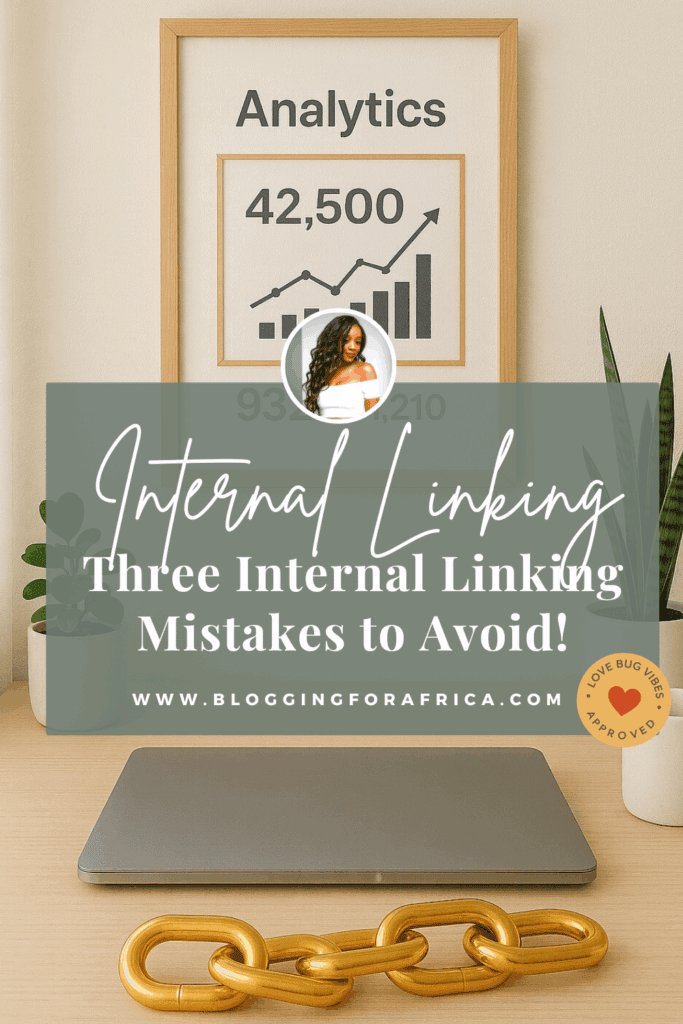Internal Linking Mistakes: Is Google Respecting Your Brand?
July 13, 2025

Could Internal Linking Mistakes Be Stopping Google From Respecting Your Brand?
Alright, love bug, it’s that time again! Today I’m answering a quick but important question that I know a lot of business owners — especially those using content-driven websites as their primary content strategy — have:
Could internal linking mistakes be stopping Google from respecting your brand?
This is such a good question because it’s one of those little things that can make a huge difference.
One thing you’ll learn early on about blogging is this: it’s not just the big things that matter.
More often than not, it’s the small details that quietly set your brand apart — and if they’re missing, they can cost you traffic and your blog’s overall growth.
And you know what we say around here. Ain’t nobody got time for that.
So, in the post I just published: How to Make Google Respect Your Brand and Website, I talked a little bit about internal linking. You can check that out later, but for now, let’s jump right in.

📌 Loving this already? Pin this post now so you can come back anytime to quickly fix these internal linking mistakes. Trust me, love bug, Google will love you for it.
How Internal Linking Mistakes Affect Google Respect and Blog Growth
So first things first.
What Is Internal Linking and Why Does It Matter for Google Respect?
Internal linking is simply the practice of linking one page or blog post on your site to another relevant page or post.
So, why does it matter for Google respect? Because Google uses these links to figure out how your content is connected — and how valuable it is.
Here’s why it matters:
- It keeps readers on your site longer. Have you ever read a blog post and thought, “I’d love to learn more about this?” Internal links give readers that next step right away.
- It helps Google understand your site structure. The way your pages link together tells Google the bigger picture of what your site is about.
- It builds your website authority over time. Think of it as gently guiding both your readers and Google through your content, proving your site is strategic and worth recommending.
What Are the Most Common Internal Linking Mistakes?
Now let’s talk about the most common internal linking mistakes.
This part is important because if you can fix these mistakes that might already be happening on your blog — or avoid them in the future — it can make a huge difference for your blog’s overall growth.
So here are the top three you absolutely need to know. There are more, of course, but these are the ones you want to focus on first.
1. Not Linking to Older, Relevant Posts
One big mistake is thinking, “Oh, I wrote that post two months ago, six months ago, a year ago… I don’t need to worry about it anymore.”
So here’s the good thing — blogging don’t quite work like that.
Your posts don’t “expire.”
A blog post is never too old to link back to — especially if you’ve updated it with fresh content.
Even if that post is five years old, you can (and should) link to it, as long as it’s updated.
Adding a quick line like “Updated [date]” in the post also lets readers and Google know it’s fresh.
Personally, I keep an Excel sheet with all my blog posts listed. That way, when I’m writing new content, I can quickly see which older posts make sense to link to.
2. Overusing Exact-Match Keywords in Your Links
Another mistake is overdoing it with exact-match keywords in your anchor text. Forcing the same keyword into every single link can look spammy — and Google doesn’t love that.
That said, you do still want to use your exact blog post title most of the time when you’re linking to it.
Why? Because the more consistently you link to that post using the same phrase, the easier it is for Google to understand exactly what that post is about when crawling your site.
You don’t have to do it every time — little tweaks here and there are fine — but as a general rule, stick with the post title. And no, your audience won’t get tired of seeing it repeated.
3. Leaving Orphan Pages Behind
And lastly, you just want to be sure your blog doesn’t have any orphan pages.
What’s an orphan page? It’s simply a blog post or page that doesn’t have any other internal links pointing to it.
So, you don’t want that because it makes it harder for Google to crawl your site — and you want Google consistently crawling your blog posts.
In Conclusion
So as you can see, internal linking might seem like a small thing, but it’s actually one of those key details that can move the needle forward for your blog.
Yes, it’s important for Google — it helps them crawl your site more effectively and understand how your content is connected. But keep in mind, internal linking is also super beneficial for your audience.
When you’re creating blog posts, you’re not always able to give every single detail in one post.
That’s where internal links come in — they guide your readers to other helpful posts, giving them the full picture without overwhelming them all at once.
I’ll be sharing a separate blog post soon on how many internal links to include in each post as a rule of thumb, so keep an eye out for that.
✔️ Fix these three internal linking mistakes, and you’re already a step closer to earning Google’s respect — and yes, that means more traffic, more authority, and more growth over time.
Ready to dive deeper into strategies that help Google respect your brand? Here are three other posts you’ll love:
3 Ways to Make Google Respect Your Brand and Website
How to Create a Google Sitemap (The Quick and Easy Way)
Google Search Console: The Secret Sauce to Grow Your Blog Fast! – Part One
Okay, until next time. Cheers! 🥂
Your favorite foodie and blogger, Keesh
Loved this post? Don’t be shy—share it below! Your shares make a difference. ❤️
For Global Business Owners & The Ambitious Creative Entrepreneur:
Unlock my Proven GAB-LC Method – A No-Fluff, Step-by-Step Strategy to Launch Your Blog, Increase Your Website Traffic, and Boost Product Sales - Get Your Free Blog Checklist & Take Action and Start Building Your Blog in Just 5 Days!
Leave a Reply Cancel reply
© 2024 Blogging For Africa All rights reserved Website Designed By Keesh
No Discrimination Policy
Contact
Unlock my Proven GAB-LC Method – A No-Fluff, Step-by-Step Strategy to Launch Your Blog, Increase Your Website Traffic, and Boost Product Sales - Get Your Free Blog Checklist & Take Action and Start Building Your Blog in Just 5 Days!
Enter email you would like information sent to.
Called To Blog
Free Blog Checklist
You're all signed up! Keep your eyes on your inbox for the information.